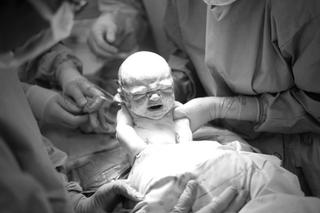
Nowhere in India Are C‑Section Rates What They Should Be
Some parts of the country see too many Cesareans; others see too few.

Researchers drawing on data from the latest National Family and Health Survey (2015-2016), have charted some of the main trends in Cesarean births in India — namely, that no place in the country is getting the number of C-sections right. While some parts of the country see too many, unnecessary C-sections above and beyond international benchmarks, others see far too few life-saving procedures.
If current trends and India’s economic progress continue, the researchers conclude, the proportion of births delivered by C-section will continue to increase in the future, well above medically justifiable levels, unless efforts are made to curb the over-medicalization of childbirth.
“India will become home to the largest number of Cesarean births in the world,” the study warned.
Cesarean deliveries — a surgical procedure in which the fetus is delivered through an incision in the mother’s abdomen and uterus — are necessary in case of specific pregnancy and delivery complications, such as when the baby has trouble breathing or the heartbeat isn’t steady. However, they have also become a popular choice for patients and their families as a means to ensure a child is born on an auspicious date or a particular time; others cite cosmetic reasons, such as wanting the vagina to remain tight, for choosing a C-section over vaginal birth. Still others perceive a C-section as less risky than a vaginal birth.
But an increase in C-section births corresponds to an increase in maternal and prenatal mortality rates, cites the researchers. Other studies have previously mentioned that women are three times more likely to die while delivering via C-sections than through vaginal births and are also at a higher risk of pain and infection at the site of incision after childbirth.
The study, led by researchers Christophe Guilmoto and Alexandre Dumont from Institute of Research for Development, found that between 2010 and 2016, the rate of C-sections in India was 17.2% — an estimated 4.38 million Cesarean births per year — which is almost twice the global average and far beyond the benchmark of 10% to 15% advised as necessary by the World Health Organization (WHO).
Article continues below
Despite the associated risks, India’s overly high C-section rates are not the most worrying part. The more striking finding is the significant disparity in the number of such births, with some parts of the country recording numerous unnecessary Cesarean births, while others lack adequate necessary procedures.
“There is a substantial deficit of Cesarean deliveries among underprivileged groups, and almost two million excess Cesarean births every year among more advanced sections of the population,” said the authors.
Talking of excesses, the South Indian states of Telangana, Andhra Pradesh, Kerala, Karnataka and Tamil Nadu accounted for 35% of C-section births in India, the highest in the country.
However, in a large stretch of North India, comprising regions extending from Rajasthan to Bihar and Jharkhand, fewer than 10% of births were Cesarean deliveries. This area also included large patches of mountainous or forested districts of Northeast India, Uttarakhand, South Chhattisgrah and Orissa and other northeastern states such as Nagaland, Meghalaya and Arunachal Pradesh.
Related on The Swaddle:
The Truth About C‑Section Delivery
The disparity reflects broader issues of access to health care. Where C-sections are lowest, home delivery rates are highest, accounting for more than 30% of births in several populous states of North India, such as Bihar and Uttar Pradesh. In contrast, in South India, and in more prosperous states such as Maharashtra and Punjab, more than 90% of births took place in hospitals.
But the type of hospital in which these births occurred also affected whether babies were born by C-section; government clinics recorded a Cesarean rate of 11.9% in 2015-16, in line with international guidelines, while private clinics increased their C-section rates from 27.5% to 40.8% in the same period — far beyond the percent of births likely to require a C-section delivery, per the WHO.
To sum it up, India recorded an estimated annual excess of 1.8 million Cesarean deliveries from 2010 to 2016 that took place in more advanced regions and among more affluent classes. During the same period, a yearly deficit of 0.5 million Cesarean births were recorded among underprivileged populations.
Related on The Swaddle:
The C‑Section Rate Is Still Rising, and Shaming Doctors Won’t Solve It
The researchers say that a Cesarean delivery does not necessarily ensure the mother and the baby are healthy. To prove this, they point to the fact that Telangana, the state with the highest C-section rate, did not have the lowest mortality rate. At the same time, states where C-section rates were lower than 10% had higher maternal and neonatal mortality rates.
This analysis highlights the double burden facing today for India’s health authorities. On the one hand, they need to improve access to Cesarean deliveries when necessary for the health of the baby and mother in many districts of North India and among the poor; on the other hand, they must find ways to discourage the growing overuse of Cesarean deliveries in more advanced parts of the country.
Anubhuti Matta is an associate editor with The Swaddle. When not at work, she's busy pursuing kathak, reading books on and by women in the Middle East or making dresses out of Indian prints.
Related


“From Durban to Tomorrow” Shows the Fight Against HIV Is Far From Over
